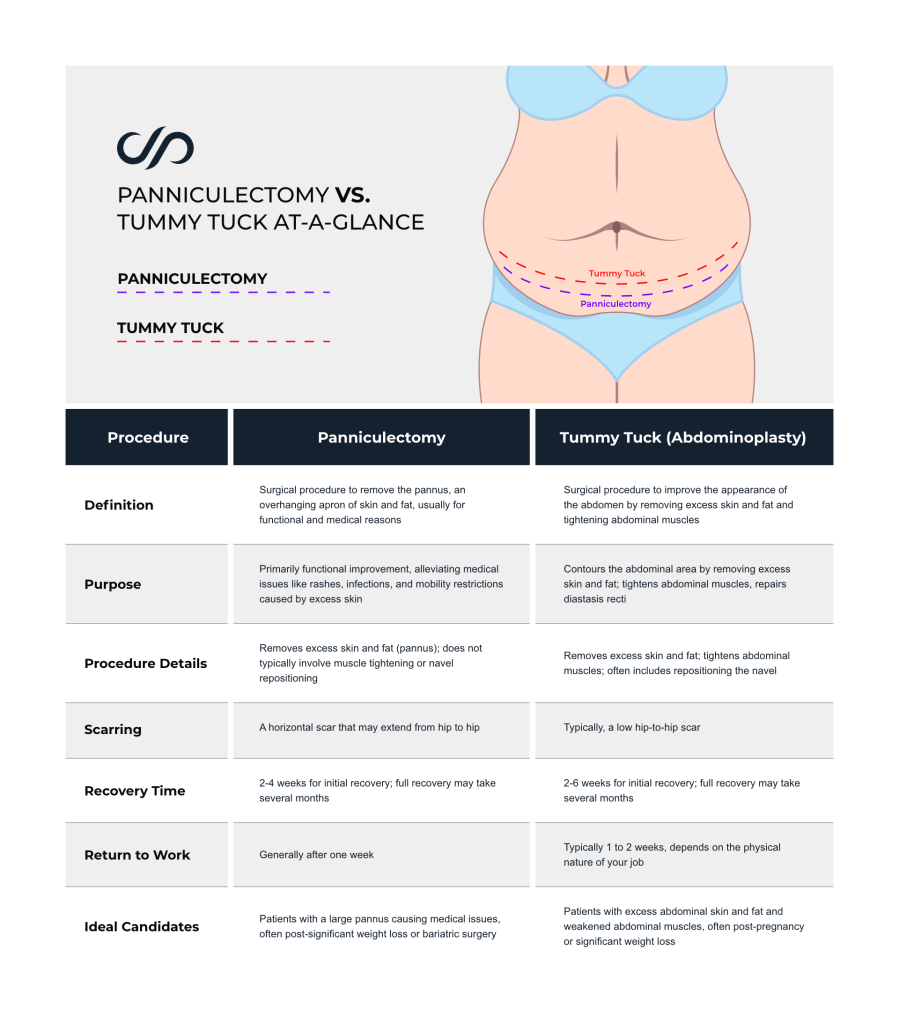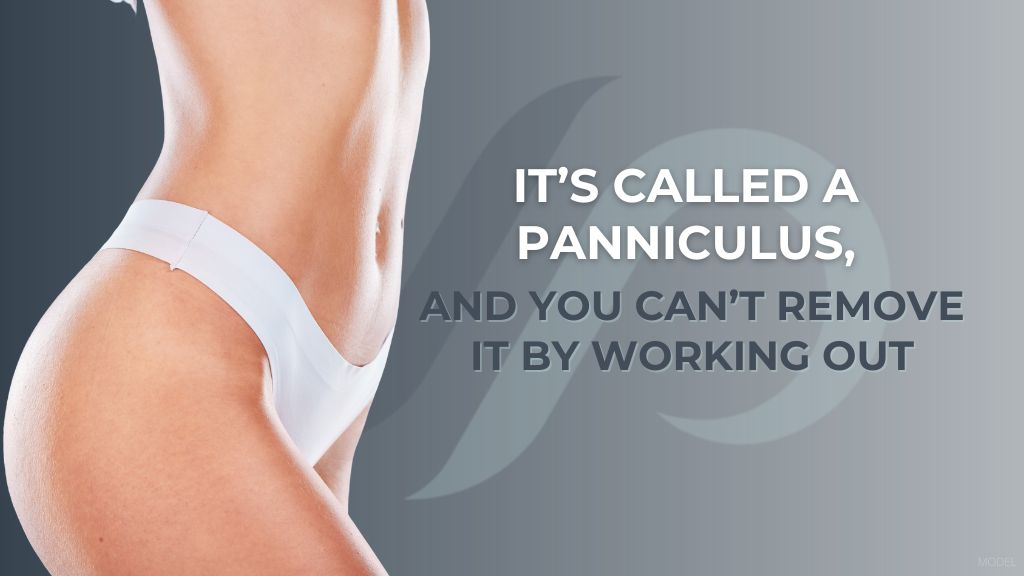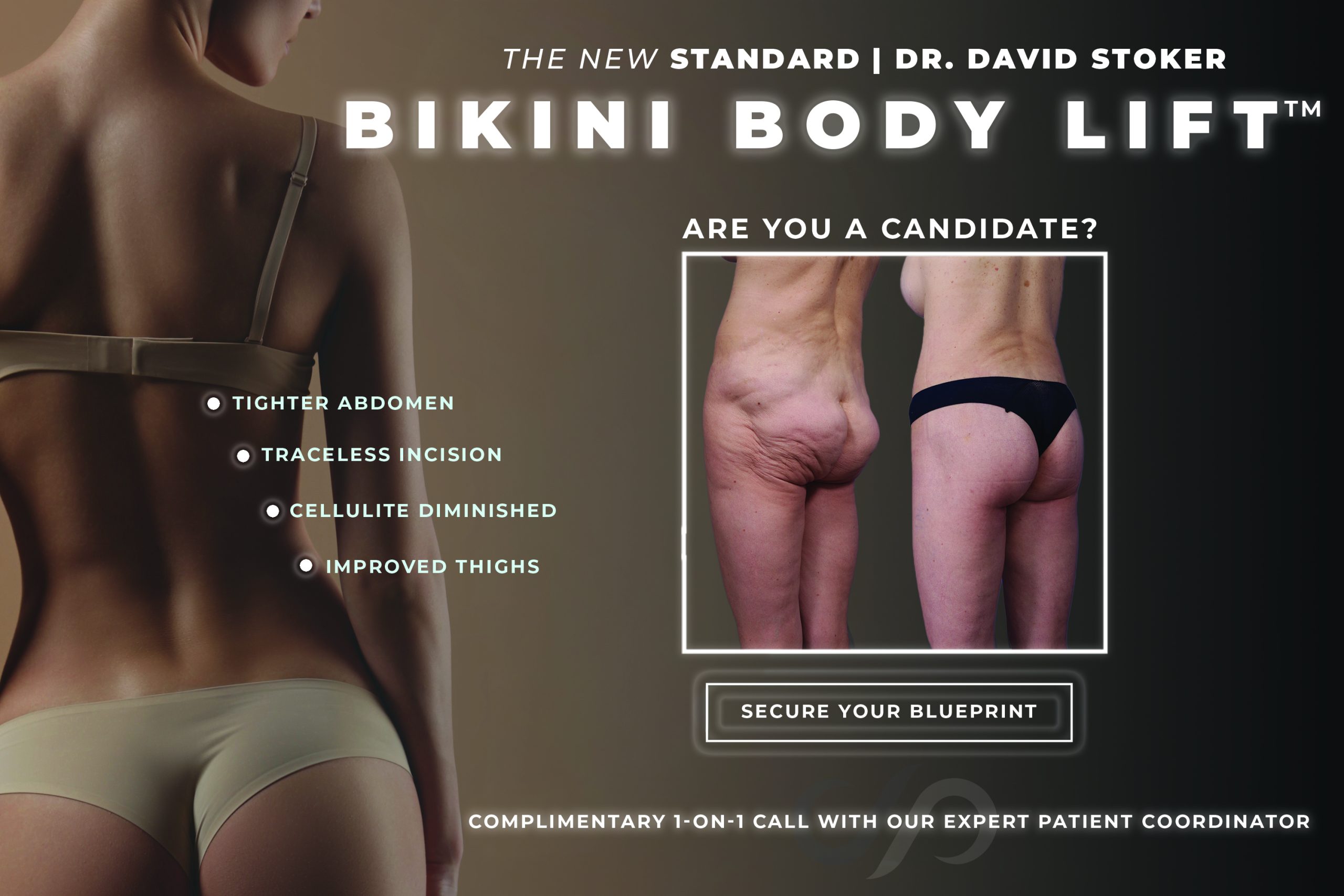Life events such as childbirth and significant weight loss can lead to loose, hanging skin that doesn’t snap back into place, even with a dedicated diet and exercise routine. If you’ve worked hard to achieve your weight loss goals or gone through the transformative process of pregnancy, you may find yourself with excess skin that remains despite your best efforts, often leading to self-consciousness and discomfort.
This blog post will explore 2 procedures, panniculectomy and tummy tuck (abdominoplasty), which target the midsection and may be the solution you’re looking for. By understanding these options, you can make an informed decision in consultation with your surgeon about which is best for you.
What Is a Panniculus?
“Panniculus” refers to the apron of excess abdominal skin that hangs over the waist after significant weight loss or pregnancy. This hanging skin can cause discomfort, skin irritation, and hygiene issues.

Understanding Panniculectomy
A panniculectomy is a modified tummy tuck that focuses on the lower abdomen. This procedure could be beneficial if you have a large amount of skin hanging from the lower abdomen, typically following weight loss. The panniculectomy improves only the lower abdomen, removing problematic folds of skin while reducing risks and recovery time for overweight patients.
During a panniculectomy, I remove the hanging skin and fat from the lower abdomen with a wedge resection. I then bring the edges of fat and skin together with a layered closure. This procedure is less complex than abdominoplasty but provides only minimal improvement to the central and upper abdomen.
Benefits of a Panniculectomy
A panniculectomy offers significant functional benefits beyond the cosmetic improvements. Removing excess skin improves mobility, reduces skin irritation, and enhances hygiene. These functional benefits can lead to a noticeable improvement in your quality of life, particularly if you’ve struggled with the physical challenges posed by the panniculus after significant weight loss.
Candidates for Panniculectomy
You may be a good candidate for a panniculectomy if you have:
- Loose abdominal skin confined primarily to the lower abdomen
- A substantial need for removal of the hanging skin, but medical problems or advanced age that would make a less complex operation desirable
More weight to lose, but find the lower abdominal skin (pannus) so debilitating that it impedes further weight loss.
Understanding Tummy Tuck
A tummy tuck, or abdominoplasty, is a comprehensive procedure that addresses multiple concerns in the abdominal area. This procedure removes excess skin (and fat when combined with liposuction) and tightens the abdominal muscles, providing a more contoured and toned appearance.
During a tummy tuck, I make incisions as low as possible on the abdomen—just above the pubic area—so you can wear virtually any bikini bottom, low-cut pants, or any other fashion that reveals most of your midsection.
The key elements of a tummy tuck include:
- Removing extra skin and fat from the lower abdomen through a lower abdominal incision
- Tightening abdominal muscles to create a flatter abdomen
- Repairing diastasis recti (separated abdominal muscles)
- Pulling down the loose skin of the upper abdomen like a window shade to smooth the entire area
- Creating a new opening for the bellybutton in a natural-looking location
- Rejuvenating the pubic area (mons pubis), which dramatically enhances the overall results
Patients often combine a tummy tuck with other surgeries, such as liposuction or breast enhancement, for more comprehensive body contouring results.
Benefits of a Tummy Tuck
A tummy tuck results in a flatter and attractively contoured midsection. This procedure can also improve your posture and repair diastasis recti, a condition that occurs when abdominal muscles separate during pregnancy. Many patients report a boost in self-confidence and body image following a tummy tuck, as the results can be transformative.
Candidates for a Tummy Tuck
You may be a good candidate for a tummy tuck if you have some (or all) of the following concerns:
- Loose skin on the lower abdomen
- Stretch marks on the lower abdomen
- Abdominal muscle laxity
- Pubic laxity
- Diastasis recti (separated abdominal muscles)
Candidates for body contouring surgery should be in good overall health. When you visit for a consultation, I’ll help you understand which procedure best fits your needs.
Recovery and Aftercare
Recovery from panniculectomy and tummy tuck surgery involves careful postoperative care to ensure the best results and minimize complications. Here is an overview of the recovery process for each procedure, highlighting the differences:
Panniculectomy Recovery:
- Duration: Most patients take at least one week off from work.
- Initial Discomfort: Since the procedure focuses only on skin and fat removal, the initial discomfort is typically less severe,
- Activity Restrictions: You should begin walking within hours of surgery to promote circulation and avoid strenuous exercise for approximately 6 weeks.
Tummy Tuck Recovery:
- Duration: Due to the complexity of the surgery, full recovery generally takes longer than for panniculectomy. Most patients take 1 to 2 weeks off from work.
- Initial Discomfort: Expect more soreness and difficulty standing upright for 1-2 weeks after surgery due to muscle repair and tightening.
- Activity Restrictions: You’ll gradually return to exercise during the ensuing 6 weeks, with more stringent activity restrictions initially than for panniculectomy.
Learn more about recovery after abdominoplasty in our related blog post.
Ready to Take the Next Step?
If you believe you’re a candidate for a panniculectomy or a tummy tuck and want to learn more about the procedures, I encourage you to request a consultation or call my office (310) 300-1779 to schedule an appointment.
Updated August 2024







Leave a Reply